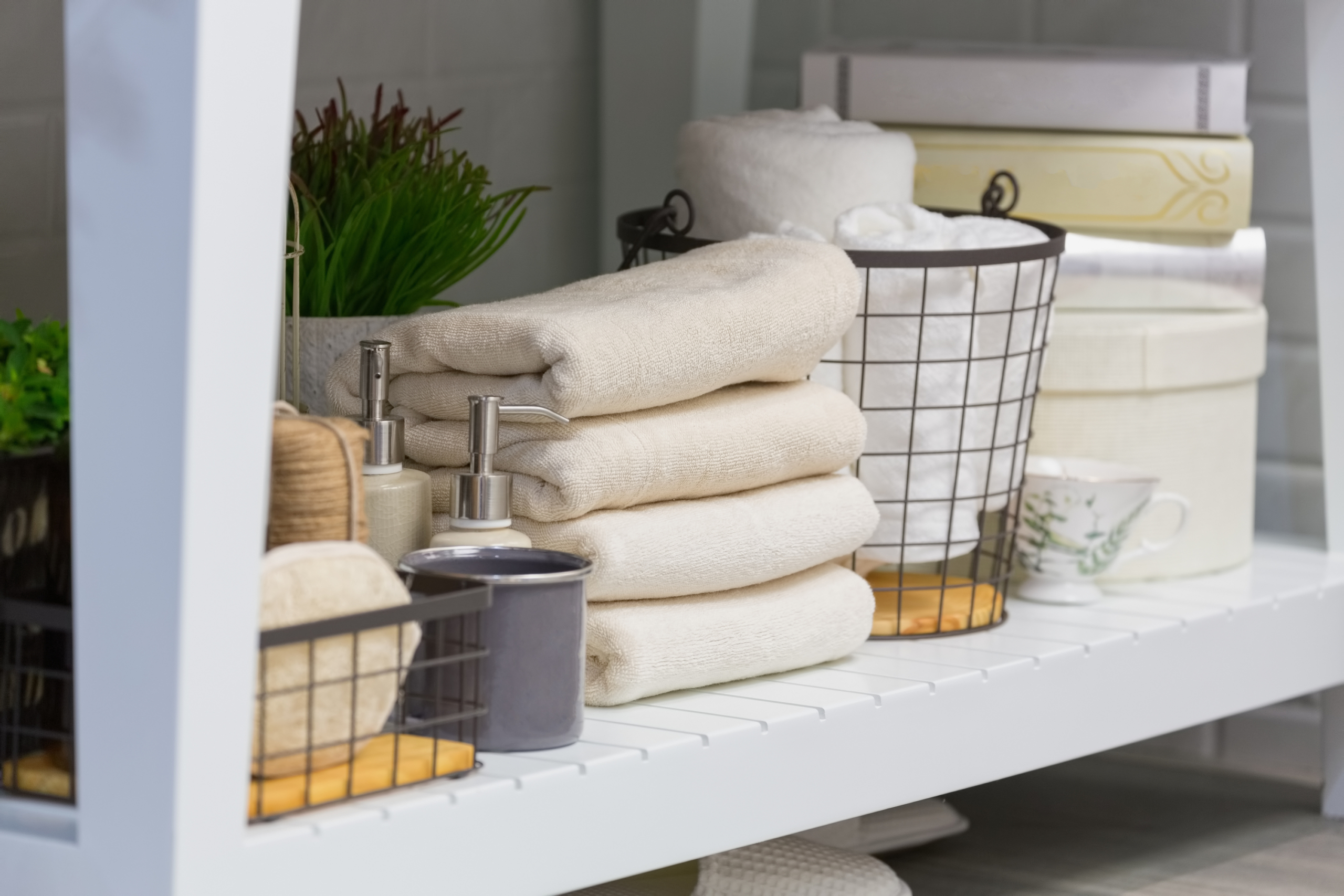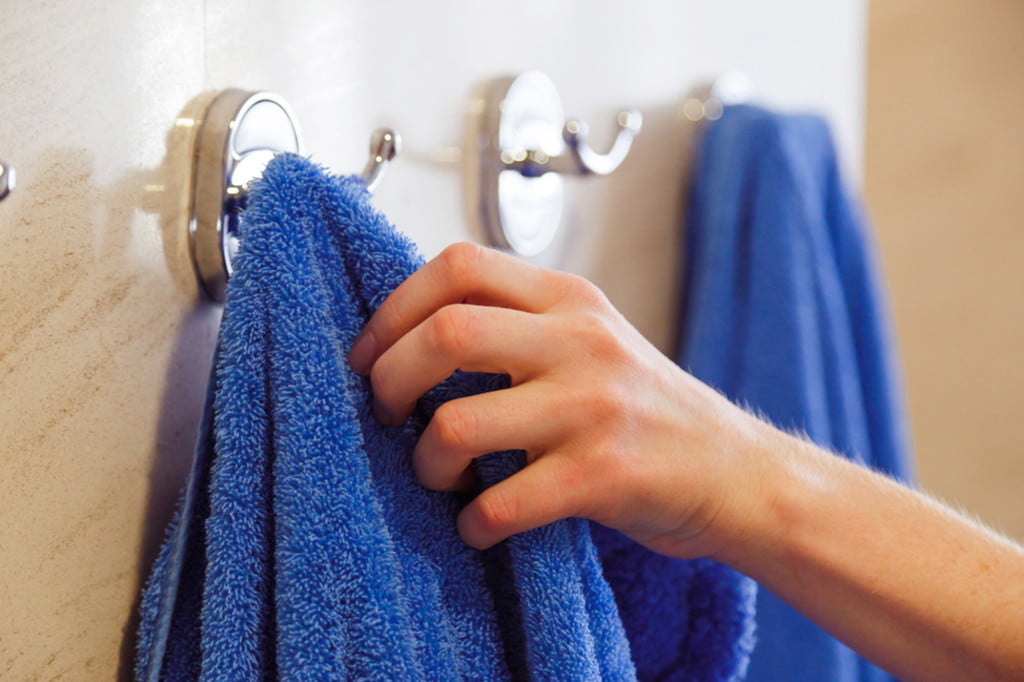
We use our clothes, our sheets, and our towels a lot, and we always want our laundry to be fresh and clean. But how clean are your towels, really? Maybe you’ve seen those trending TikTok videos of people filling their bathtubs with what they thought were clean towels and linens. Those fabrics ended up producing gross, murky water a few hours later.
If you’ve seen those videos, you were probably grossed out, and maybe now you’re even wondering what kind of dirt and grime is hiding in your “clean” laundry. We’re here to tell you everything you need to know about laundry stripping; particularly how you can strip your bathroom towels.

What is laundry stripping?
Laundry stripping is a cleaning practice where you soak fabrics to get rid of hidden oils, dirt, and grime that stick stubbornly to your laundry. Typically, laundry stripping recipes use hot water, Borax, washing soda, and laundry detergent to really get in and clean those fabrics thoroughly. It’s a lengthy and time-consuming process, but after you strip your laundry once, you shouldn’t have to do it again for a long time.

Should you strip your laundry?
The longer you have those towels or sheets, the more they absorb and retain stubborn dirt, hard water minerals, body oils, and soap residue. As the years go by, the more likely a standard towel wash cycle will struggle to rid those fabrics of the grime. Here’s how to know if you should strip your laundry:
You have hard water
If you have hard water in your home, it means your water has higher levels of minerals that are deposited onto the fabrics you wash. Excess minerals stick to fabrics, carrying dirt and grime with them, and they make the material feel stiff or rough, and they are difficult to get out.
You use homemade laundry detergent
If you use a homemade laundry detergent, you may notice a sticky film on your laundry. This film occurs because homemade detergent doesn’t rinse off fabrics as thoroughly as store-bought detergents. If you haven’t been diligent with the rinsing process, a buildup of residue occurs after a while. If this is the case, a good laundry stripping session may do your fabrics good.
Your towels aren’t as absorbent as they once were
After a lot of washing, drying, and laundry products, your towels get a film that prevents water from being absorbed into their fibers. Stripping your towels will remove the film and restore your towels to that gloriously absorbent state that you bought them in.
Your fabrics seem old and dingy
If your towels and sheets don’t seem all that fresh and clean, even right out of the wash, it might be because of hidden dirt and grime in the fibers. This tends to happen over time, but it can also occur due to ineffective detergents or overloaded washing machines. Hidden dirt and bacteria can cause a stiff feel, a discolored appearance, and even an old and musty smell. Stripping these fabrics will give them a deep clean to rid them of the grime.

How often should laundry stripping be done on towels?
While occasional stripping can help remove buildup and restore your towels’ softness and absorbency, excessive stripping uses a lot more water, energy, and other resources unnecessarily. It can also lead to premature wear and tear on your towels or noticeable fading in the fabric’s color. Depending on the fabric, too-frequent stripping can also cause towels to become rough to the touch. In general, towels shouldn’t need to be stripped except once every few months.

Laundry stripping guide: How to strip towels
Since towels tend to be made with dense, thick materials, they often absorb and retain residues and grime quicker and in higher amounts. For this reason, we think your towels are a great place to start your laundry stripping journey. You can strip your towels in the bathtub, in a top-load washing machine, or even in a bucket that’s large enough to hold the stripping load. You’ll use:
- 1 part Borax
- 1 part washing soda
- 2 parts laundry detergent of your choice
The below instructions are for use in a standard-sized bathtub.
What you’ll need
- 1/4 cup Borax
- 1/4 cup washing soda
- 1/2 cup laundry detergent
- Long stirring tool (such as a stick or broom handle)
Instructions
- Collect the clean towels you’ll be stripping.
- Fill your bathtub halfway with hot water.
- Pour in the Borax, washing soda, and laundry detergent. Stir until the powders dissolve in the water.
- Place your towels into the mixture and make sure you completely submerge them underwater.
- Let the towels soak for up to 5 hours until the water has cooled completely.
- Remove the towels and transfer them to a freshly cleaned washing machine.
- Run them through the rinse cycle (you don’t need to add more laundry soap since they are already clean).
- Transfer to the dryer and dry the towels like normal.
- Drain and wipe out your bathtub.

Caution: Laundry stripping warnings you need to know
The process of laundry stripping does tend to be fairly harsh, especially since it uses hot water. There’s a chance that any dyes in your fabric could bleed out and discolor lighter items. There’s also the possibility that clothing items with special care instructions may become damaged. For these reasons:
- Don’t strip colored and white fabrics in the same batch.
- Don’t strip delicates or other fragile fabrics.
- Don’t overload the bathtub, as the stripping process won’t be as effective.
- Check care instructions on fabric labels before stripping.

Adjust your laundry routine to minimize the need for laundry stripping
To minimize the need for laundry stripping, it’s essential to adjust your laundry routine proactively. First and foremost, sorting your laundry properly is crucial. Grouping similar fabrics and colors together can prevent dye transfer and reduce the likelihood of needing to strip your laundry later.
Additionally, using the right amount of detergent is vital. Avoid overloading your machine with detergent as it can lead to residue buildup on your clothes. Instead, follow the manufacturer’s recommendations and consider using a detergent specifically designed for your washing machine type, whether it’s a high-efficiency or traditional one.
Lastly, don’t forget to maintain your washing machine by cleaning the drum, seals, and detergent dispenser regularly to prevent mold and mildew growth. By adopting these adjustments to your laundry routine, you can keep your clothes clean and fresh while minimizing the need for frequent and labor-intensive laundry stripping.
You may have thought laundry stripping was simply a fad, but the process — which existed long before TikTok — actually does deep clean your laundry quite effectively. If your towels are feeling rough, not absorbing water, or looking dingy, it may be time for a nice towel-stripping session. With the recipe and instructions we’ve discussed, stripping your towels will make them softer, fluffier, brighter, and of course, cleaner. You’ll be able t enjoy your towels as you did when they were brand new.



